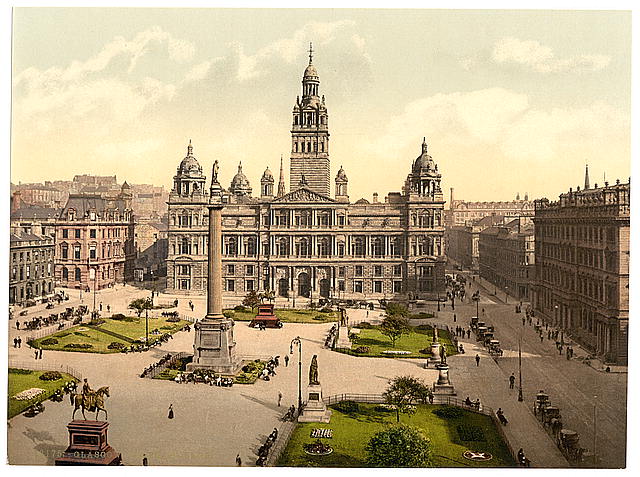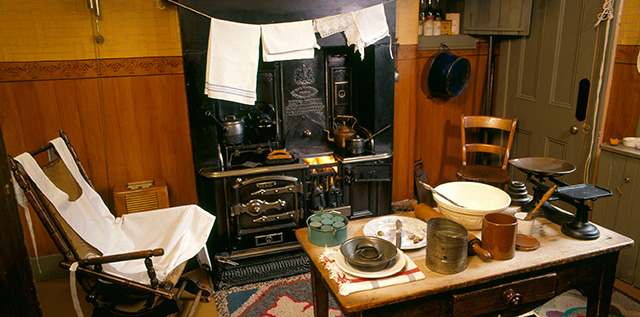Blog Archive
A Tenement Thrives in Glasgow
3,218 miles (or shall we say 5229.25 kilometers) away, at 145 Buccleuch Street in Glasgow, Scotland, a tenement stands that is very similar to the one at 97 Orchard Street. The Tenement House is preserved and maintained by a government charity called the Scottish National Trust, which also helps to manage former castles and country estates. The Tenement House’s apartments, or ‘flats’ as the Scottish would call them, give visitors a chance to explore the challenges and successes of the building’s former owner, Ms. Agnes Toward, who moved into the building in 1911. Like our own residents of 97 Orchard Street, Ms. Toward was a working-class woman who carefully made her way to financial independence.

Cigarette cards probably provided the only affordable tour of Glasgow for our families on the Lower East Side. This view of Glasgow shows the pronounced Victorian influence on the Architecture, also evident in most tenement blocks. Photo courtesy of the New York Public Library.
Scots have been living in dwellings that can be defined as tenements (a legal term that simply means three or more families living in the same building) since the medieval times. The tenement at 145 Buccleuch St. was built in 1892 by a developer who anticipated an increase in population brought by industrialization – specifically technological developments in cotton production. Its three-storey, red sandstone structure is a common architectural style in Glasgow.

George Square in central Glasgow. Like many cities that benefited hugely from the Industrial Revolution, great production also brought wealth disparity to the city. Photo courtesy of the Library of Congress.
When Scottish tenements were built, they offered a greater diversity than the tenements on the Lower East Side. While all the apartments in 97 Orchard Street have three rooms, Scottish tenement apartments could be one to four rooms large, which allowed for a more economically diverse population. The most popular size, however, was that of the single room. The apartments in the Tenement House are retro-fitted with gas lighting to maintain authenticity – electric lights weren’t installed until 1960!
The efforts to preserve these two tenement buildings – ours in the Lower East Side and The Tenement House at 145 Buccleuch Street – makes clear the similarities between the cities and the people who lived in them. Both in Glasgow and in New York, the period during which these buildings first became important was a turning point in that city’s history. After the industrial revolution, Glasgow, which was once renowned for ship-building, became known for its industrial capacities. As in many industrial cities, a significant discrepancy in wealth developed between the populations who owned the factories and those who worked in them.
In Glasgow’s history, the majority of the population moving into the city was not from overseas, but rather from the countryside. With technological developments in processing cotton and cotton-based products, low-skill jobs were suddenly an enormous pull for workers. Individuals found jobs overwhelmingly in the garment industry – at one time, the cotton industry employed a third of the city’s residents. Whereas these tenement-dwelling populations came to Glasgow through ‘pull factors,’ most tenement- dwellers in New York arrived as the result of push factors, such as famine, religious persecution, and military conscription.

A row of red sandstone fronted tenements just like the Tenement House at 145 Buccleuch Street. Photo courtesy of the National Trust for Scotland.
Ms. Toward’s story will sound familiar to visitors of our own tenement; Ms. Toward’s mother was a dress-maker who worked out their apartment, but Ms. Toward learned stenography and became a typist. In her achievement of a white-collar position, Ms. Toward’s story resembles that of the immigrants who lived in our tenement on the Lower East Side.
Ms. Toward’s mother and many of the residents of our tenement did what they could to find a place for themselves in their new city. What these hard working people could not achieve in their own lifetimes, they hoped would be achieved by their children – a hope that people continue to share all across the world.

A view of the Tenement House in Glasgow preserved to appear as it did when Miss Agnes Toward lived there from 1911 to 1965 when failing health prompted her to move. Photo courtesy of the National Trust for Scotland.
– Posted by Julia Berick, Marketing and Communications Coordinator
